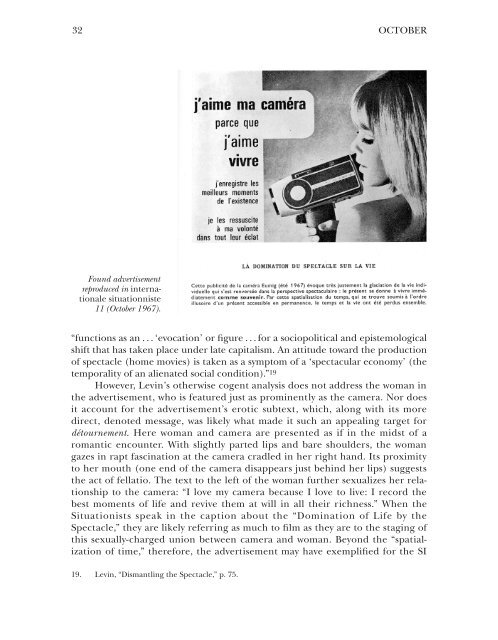The Sex of the Situationist International* - 1000 Little Hammers
The Sex of the Situationist International* - 1000 Little Hammers
The Sex of the Situationist International* - 1000 Little Hammers
You also want an ePaper? Increase the reach of your titles
YUMPU automatically turns print PDFs into web optimized ePapers that Google loves.
32<br />
Found advertisement<br />
reproduced in internationale<br />
situationniste<br />
11 (October 1967).<br />
OCTOBER<br />
“functions as an . . . ‘evocation’ or figure . . . for a sociopolitical and epistemological<br />
shift that has taken place under late capitalism. An attitude toward <strong>the</strong> production<br />
<strong>of</strong> spectacle (home movies) is taken as a symptom <strong>of</strong> a ‘spectacular economy’ (<strong>the</strong><br />
temporality <strong>of</strong> an alienated social condition).” 19<br />
However, Levin’s o<strong>the</strong>rwise cogent analysis does not address <strong>the</strong> woman in<br />
<strong>the</strong> advertisement, who is featured just as prominently as <strong>the</strong> camera. Nor does<br />
it account for <strong>the</strong> advertisement’s erotic subtext, which, along with its more<br />
direct, denoted message, was likely what made it such an appealing target for<br />
détournement. Here woman and camera are presented as if in <strong>the</strong> midst <strong>of</strong> a<br />
romantic encounter. With slightly parted lips and bare shoulders, <strong>the</strong> woman<br />
gazes in rapt fascination at <strong>the</strong> camera cradled in her right hand. Its proximity<br />
to her mouth (one end <strong>of</strong> <strong>the</strong> camera disappears just behind her lips) suggests<br />
<strong>the</strong> act <strong>of</strong> fellatio. <strong>The</strong> text to <strong>the</strong> left <strong>of</strong> <strong>the</strong> woman fur<strong>the</strong>r sexualizes her relationship<br />
to <strong>the</strong> camera: “I love my camera because I love to live: I record <strong>the</strong><br />
best moments <strong>of</strong> life and revive <strong>the</strong>m at will in all <strong>the</strong>ir richness.” When <strong>the</strong><br />
<strong>Situationist</strong>s speak in <strong>the</strong> caption about <strong>the</strong> “Domination <strong>of</strong> Life by <strong>the</strong><br />
Spectacle,” <strong>the</strong>y are likely referring as much to film as <strong>the</strong>y are to <strong>the</strong> staging <strong>of</strong><br />
this sexually-charged union between camera and woman. Beyond <strong>the</strong> “spatialization<br />
<strong>of</strong> time,” <strong>the</strong>refore, <strong>the</strong> advertisement may have exemplified for <strong>the</strong> SI<br />
19. Levin, “Dismantling <strong>the</strong> Spectacle,” p. 75.



